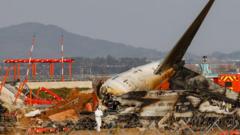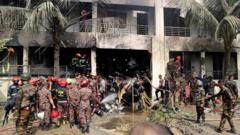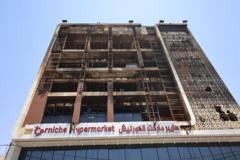The preliminary investigation report into the Air India Flight 171 crash has left more questions than answers, particularly regarding the cockpit voice recordings. With conflicting accounts from the pilots captured just before the crash and various theories circulating, the investigation is ongoing as authorities urge caution against premature conclusions.
Air India Flight 171: Preliminary Report Sparks Speculation Amid Ongoing Investigation

Air India Flight 171: Preliminary Report Sparks Speculation Amid Ongoing Investigation
The crash of Air India Flight 171 into a crowded neighborhood, killing 260, has led investigators to examine voice recordings from the cockpit as the focus of speculation intensifies.
The recent preliminary report into the tragic crash of Air India Flight 171, which claimed the lives of 260 individuals in June, has stirred a maelstrom of speculation rather than closure. This 15-page document revealed key details, such as the unexpected movement of fuel-control switches that led to a catastrophic power loss seconds after take-off, leaving investigators, aviation experts, and the public grappling with the implications.
The cockpit voice recording has become a focal point of controversy, where one pilot asked the other why a "cut-off" was performed, to which the latter responded he did not carry out that action. The confusion over who was responsible for the switch maneuver raises critical questions. At the time of the incident, with the co-pilot piloting and the captain monitoring, critical decisions were made in mere seconds, culminating in a crash shortly after take-off into a densely populated area in Ahmedabad.
Since the preliminary findings have surfaced, various media outlets, including The Wall Street Journal and Reuters, have shifted their focus toward the senior pilot, Captain Sumeet Sabharwal, and the circumstances surrounding the flight. Speculative theories range from pilot error to malfunctioning aircraft systems, yet all speculation runs the risk of diverting attention from factual inquiry.
India's Aircraft Accident Investigation Bureau (AAIB) has decried the sensationalism of media reports, arguing that these narratives are not only irresponsible, but potentially damaging to the ongoing investigation. Jennifer Homendy, chair of the National Transportation Safety Board (NTSB), echoed this sentiment, stating that the complexity of aviation investigations prohibits rushing to conclusions.
In the aftermath of the report's release, the Indian Commercial Pilots' Association condemned the pressure to assign blame to the flight crew prematurely. They emphasize the necessity for restraint during the investigation process until all essential evidence is analyzed, including the complete cockpit voice recorder transcript, which is expected in the final report.
An unnamed air accident investigator highlighted that while it is suggested that one of the pilots could have inadvertently moved the switches, this assertion remains uncorroborated. Potential aircraft faults have also been suggested, including a malfunction within the Full Authority Digital Engine Control (FADEC) system, which could potentially account for the events leading to the crash.
Experts predict that as evidence accumulates, the presence of clear documentation and data will help discern the conclusive narrative of the incident. The investigation may ultimately pinpoint whether the tragic events were a result of a deliberate action, a miscommunication between the flight crew, or a technical failure.
As authorities continue their inquiries, experts plead for judicious interpretation of these unfolding details. The AAIB indicated that the investigation is far from complete, with the final report expected to outline the root causes and provide recommendations moving forward. The ambiguity surrounding the events of that fateful day continues reverberating, leaving families and the aviation community alike anticipating answers that may be long in coming.



















